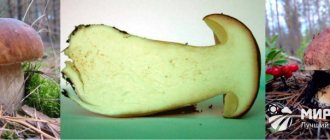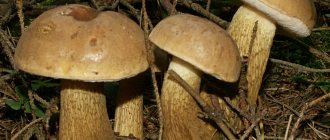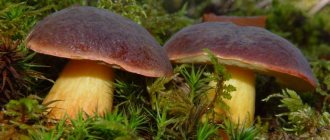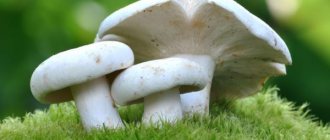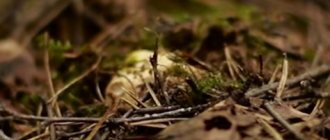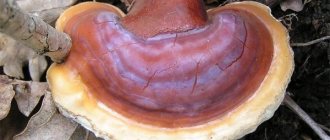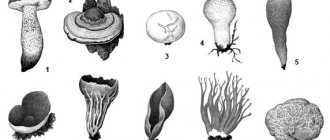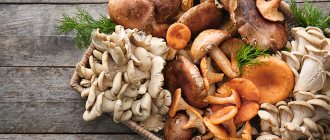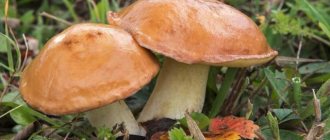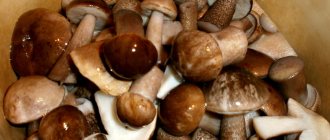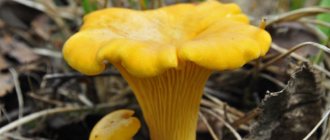Mushrooms
0
1406
Article rating
Kira Stoletova
The boletus mushroom is a whole genus that is part of the Boletaceae family, class Agaricomycetes, department Basidiomycetes. There are about 300 species, most of which are edible. Distributed throughout the Northern Hemisphere, except for tundras, steppes and deserts. It is considered one of the most valuable edible mushrooms.
Boletus mushroom
Where porcini mushrooms grow: in which forests can boletus mushrooms be found?
In the forests where porcini mushrooms grow, the soils are predominantly sandy, but boletus mushrooms can also be found on fertile soils. More often found under birches, less often under oaks, prefers mature trees over 20 years old. It lives in the temperate and subarctic zones throughout Eurasia.
Porcini mushrooms grow from the second half of June to the end of October, but in hot weather they begin to bear fruit in May, although the largest number of mushrooms is observed in the forest from mid-July to the very end of August. In the summer months, boletus mushrooms grow singly, and in the fall - in small groups.
You can find porcini mushrooms where the forests are at least 50 years old; it is useless to look for them in young forests. Boletus mushrooms can also be found singly, but more often in groups, so when you find one mushroom, you need to look around carefully - there are probably several more growing nearby. Porcini mushrooms grow in sparse places, warm and well-lit, on the edges, clearings, forest clearings, often where there are many forest anthills. The best time to collect porcini mushrooms, when they appear en masse, is during the heading of cereals, although individual mushrooms can be found until late autumn. Depending on the places in which porcini mushrooms grow, there are four varieties: birch, spruce, pine and oak.
Conditionally edible species
Conditionally edible species include species that require additional processing during preparation. They have a bitter or pungent taste and an unpleasant odor. It is recommended to boil such mushrooms 2-3 times or soak them in water for several hours. They belong to category 3-4 in terms of culinary value.
Some types require pre-soaking
The most common conditionally edible species:
- wolfish;
- beautifully colored;
- Kelle oak tree;
- speckled oakwood;
- red flywheel;
- hare
Wolf
Wolf's boletus grows in the Mediterranean and northern Israel, forms a symbiosis with oak trees, and appears in November - January. His hat is small, 5-10 cm in diameter, with a pointed edge, and always has a pink or red tint against a brown background. The skin is dry, in young specimens it is covered with a felt coating. The hymenophore tubes are first yellow, then turn red.
The leg is bright yellow, with darker dots, smooth, without mesh. Height – 4-8 cm, diameter – 2-6 cm. The pulp is dense, yellow, then turns blue, and has no special aroma or taste. Before use, boil the mushroom 2 times for 15-20 minutes, be sure to drain the water.
Beautifully painted
The beautiful boletus got its name because of the delicate pink skin on the edges of the cap. The color of the skin is light gray, it is rough, covered with felt, and becomes smooth over time. The tubes are olive-yellow and easily separated from the fleshy part. The leg is bright yellow, tapering at the bottom. The pulp is hard. When cut, it takes on a soft blue or light blue hue.
Young specimens have a fruity aroma, but then it deteriorates. The taste is not good. Raw, beautifully colored boletus is poisonous. If you soak it and boil it 2-3 times, it is edible, but not tasty. Therefore, it is rarely collected and is classified as inedible.
Dubovik Kelle
Kelle oakweed prefers acidic soils and grows in oak groves, less often in coniferous forests. It is found in clearings in tall grass and moss. The cap is brown, sometimes has a yellowish tint. In dry weather it is soft and velvety, after rain it is sticky and slippery, like an oil can. The leg is yellow, 2-5 cm thick and up to 10 cm high, covered with red scales. The threads of mycelium are clearly visible at the base.
The pulp immediately turns blue when cut, has a sour taste, a weak aroma, and is never wormy. This species contains substances that irritate the stomach. Before use, it is soaked for 5-10 hours, then boiled for 30-40 minutes, and the broth is drained. After frying or stewing, the mushrooms become suitable for eating.
Speckled oakweed
Speckled oakweed is sometimes also called granulopod. It appears in forests from the end of August and bears fruit until October; in the southern regions it is found as early as May. The cap is fleshy, pillow-shaped, brown in color with different shades of red on it. The hymenophore in young specimens is yellow-olive, turning red with age. The stem is tuber- or barrel-shaped, reddish-yellow, with numerous red scales and specks. The middle is bright yellow, the base of the knives is reddish. Turns blue when cut. The mushroom is eaten after boiling twice a day.
Moss fly red
The red boletus is a false boletus belonging to a different genus. Previously, it was included in bolets. It is rare; representatives of this species grow in deciduous forests, near old roads and clearings. It has a fleshy and fibrous pillow-shaped cap. The color of the skin is cherry, purple, pink-red. The hymenophore ranges from golden yellow in young specimens to olive brown in aging specimens. The leg is yellow-brown, lighter on top, with reddish scales. The pulp is yellow, slightly blue when cut.
Irina Selyutina (Biologist):
The red flywheel or red boletus is classified into 4 categories of edibility. The first fruiting bodies appear in August – September. Grows in deciduous forests. Prefers oak forests.
Due to the fact that it is not found often, it is collected together with other mushrooms - “along the way.” The flesh of the leg in its lower part has an interesting and characteristic feature: red dots.
This species is rarely collected not only because it is rare in its wide distribution (area), but also because the fruiting bodies are very often affected by worms, which makes collection unrealistic.
Hare
The hare mushroom belongs to the Boletaceae family, but is not a boletus mushroom, although their description is similar. It is sometimes called chestnut or false white. The cap is reddish-brown or red, and has a velvety or powdery top. The hymenophore is white and turns yellow with age. The stem is cylindrical or club-shaped, dense in young mushrooms, loose in aging mushrooms, with chambers and voids. The middle (pulp) is white and does not change color. When cooked, it becomes bitter; if it is dried, this property disappears. You will be able to find the hare mushroom until mid-November.
Nutritional value of porcini mushroom (boletus)
The nutritional value of porcini mushroom is very high - it belongs to the first category, is very healthy, nutritious, and has an excellent taste. It is called white because it does not turn black when cut and dried. Used for cooking and frying, for pickling, drying and salting. When dried, it retains color and aroma.
Porcini mushroom is a delicious product that is used to prepare a wide variety of dishes: soups, main courses, salads, appetizers, sauces, pates, etc. It is prepared for future use in dried, salted, canned and pickled form.
However, the value of porcini mushroom is not only in its taste. It is also able to stimulate the secretion of digestive juices. It should be noted that boletus mushrooms differ markedly from other mushrooms in terms of nutrient content.
Despite all its positive qualities, it is noticeably inferior to boletus in the presence of proteins, and chanterelle and morel in the content of microelements such as phosphorus and potassium. It should also be noted that the digestibility of protein after drying the porcini mushroom increases by 80%. Dried mushroom has its own special aroma, so its powder is often used as a seasoning for various dishes.
Porcini mushroom also has other useful qualities: tonic, anti-infective, wound-healing, antitumor. Thanks to the lecithin contained in the mushroom, it is useful for anemia and atherosclerosis, liver and kidney diseases, and eye pathologies. It has a positive effect on the immune system, helps break down glycogens and fats, and remove excess cholesterol from the body.
Porcini mushrooms growing under different trees have different cap colors. The darkest porcini mushrooms grow under the spruce, and the boletus mushrooms growing under the pine have a beautiful red-brown cap.
Inedible species
Poisonous mushrooms can cause severe poisoning
The Borovik genus includes a number of species that are not suitable for human consumption. Among them there are toxic and even deadly poisonous ones. All these varieties have specific characteristics. You should definitely familiarize yourself with them in order to understand the difference between the species and not put a poisonous mushroom in your basket.
Common poisonous and inedible species:
- beautiful-legged;
- rooted;
- Le Gal;
- beautiful;
- pink-purple;
- pink-skinned;
- Satanic.
Beautiful-legged
Beautiful or beautiful-legged is an inedible, but not poisonous species. Its cap is olive or light brown, dry, fibrous in young specimens, the edge curls up with age. As the mushroom matures, the hymenophore changes color from lemon yellow to olive. It is thin, the tubes are pink in color and turn blue when pressed. The leg first resembles a barrel, then a mace or cylinder. Yellow above, carmine-red in the middle, reddish-brown below, almost colorless in aging fruiting bodies. The middle (pulp) is firm, creamy, with a bitter taste. It grows under spruce trees, less often – under deciduous trees.
Rooted
The rooting bolet, or stocky one, loves warmth and prefers the root system of deciduous trees to create mycorrhiza. This boletus is inedible, but not toxic either. The cap sometimes grows up to 30 cm. The shape is pillow or hemisphere, the edges are curved, in old mushrooms they are wavy. The color is light gray with a fawn or greenish tint, the surface is dry. The hymenophore is yellow-olive, turns blue when squeezed. The leg is lemon on top and olive on the bottom, with a thin delicate mesh, short. The middle is dense, has a pleasant aroma, but a bitter taste.
Le Gal
Boletus le Gal was discovered by the French scientist Marcel le Gal, in whose honor he received his name. The name “legal” is also found in the literature. It grows in deciduous forests, under oaks, hornbeams and beeches, and is poisonous. The cap is pink-orange, at first spherical, then convex and spread out. The hymenophore is tubular, its components (tubules) are red, and grow with denticles to the stem. The middle smells like a mushroom, is whitish or yellow, and turns blue when cut. The leg is the same shade as the cap, covered with a red mesh, barrel-shaped.
Beautiful
The beautiful boletus is found on the west coast of the United States in summer and autumn. It is toxic, causing stomach upset and diarrhea, but there have been no fatal poisonings. The cap has a specific reddish tint, sometimes olive-brown. The tubes of the spore-bearing layer are yellow-green, the pores are blood-red. The leg is swollen, reddish with brown and a characteristic purple or scarlet mesh.
Irina Selyutina (Biologist):
Belonging to the category of poisonous mushrooms, the beautiful boletus can cause stomach discomfort. After some time, the symptoms (diarrhea, nausea, vomiting, abdominal pain) disappear without a trace. No deaths have been reported as a result of poisoning by the beautiful boletus in its natural habitat (mixed forests of the west coast of America and the state of New Mexico).
The pores of the hymenophore are painted in a fairly bright color - blood red, and when pressed on they acquire a blue tint.
This fungus is a mycorrhiza-former. It forms fungal roots only with representatives of coniferous tree species.
The fruiting season begins at the end of summer and lasts until the end of autumn.
Pink-purple
Boletus purple, or pink-purple, has a characteristic cap color. On a gray background there are spots of wine, purple, brown-red or pink shades. If you turn the fruiting body over, blood-red pores are visible, but the hymenophore itself is olive-yellow. The leg is club-shaped with a thickening at the bottom, covered with a reddish mesh. The middle (pulp) is firm, with a sour-fruity smell. When cut, it first turns blue, then turns black, and over time becomes wine-red. The species grows on limestone soils and in deciduous forests.
Pink-skinned
The pink-skinned bolet is a rare variety. Causes stomach upset, diarrhea, if the dose of mushroom consumed is high - convulsions and loss of consciousness. The hat first takes the shape of a ball, then a pillow. The color is brown-gray with a reddish coating on the edges, the surface is smooth or velvety. The pores are initially yellow, over time they acquire a scarlet tint or carmine color, the tubes are olive-yellow. The leg is lemony on top, bright red underneath, covered with a reddish mesh. The middle is lemon yellow and turns blue when cut.
Satanic
The satanic mushroom, or satanic bolete, looks specific and is difficult to confuse with an ordinary white one. The hat is light gray, can be olive or ocher in color, and pink stains are often visible on it. Upon careful examination of the hymenophore, it becomes noticeable that the tubes are yellow-green or yellow-olive. The pores change color from yellowish to red, carmine and blood red. When pressed they turn blue.
The leg is yellowish, carmine or orange when cut. The top is covered with a red mesh with rounded cells, the shape is tuberous, tapering at the top. If you cut a mushroom, it first turns red, then turns blue; old specimens smell unpleasant. The fungus causes damage to the liver, nervous system, and spleen.
What does the cap and stem of a porcini mushroom look like?
The cap of the boletus is dry and smooth
The lower tubular part of the cap is initially white
The cap of a young porcini mushroom is spherical; with age it becomes hemispherical, sometimes flat. The lower tubular part of the cap is first white, then yellow or yellow-greenish, with small rounded pores, occupying one to two thirds of the thickness of the cap. What size is the cap of a porcini mushroom? As a rule, the diameter of the mushroom cap does not exceed 7–8 cm, but if you are lucky, you can meet a giant with a headdress up to 30 cm in diameter.
Edible species
Edible boletus species are the most popular. They are found in summer and autumn in coniferous, deciduous and mixed forests. These mushrooms have similar features. Many people find different species, but give them a common name.
Porcini mushrooms are valued for their taste
The most common edible varieties are:
- white;
- birch;
- oak (mesh);
- bronze (spike);
- Burroughs;
- two-color;
- yellow;
- golden;
- royal (woody);
- porosporous;
- appendage;
- Fechtner;
- Horton;
- common oakwood;
- semi-white;
- maiden.
Porcini
The boletus mushroom is the most famous species. It got its name because of its light color that persists during cooking and drying. The cap in young specimens is semicircular, cushion-shaped, then in older specimens it becomes flat. Shade from beige to light brown. The hymenophore is initially white, then turns yellow or greenish. The leg is elongated and thickened, grows up to 20 cm, and has a barely noticeable mesh pattern. The pulp is dense, white and does not change color when cut.
The white mushroom appears in the forest more often from the beginning of June. Subsequent growth occurs in mid-July, August, and the first half of September. The season ends in October. Productivity depends on the weather, the highest - in warm, humid summer or autumn.
White birch
The birch species is similar to the regular white one. The main difference is that the fruiting body is lighter in color; in young fungi it is almost colorless. It grows up to 15 cm. At an early age, the cap has the shape of a cushion. The leg is whitish-brown with a mesh on top, looks like a barrel. The middle is dense, white, the color does not change when cut. Mushroom aroma.
Most boletus mushrooms are found near forest paths, clearings and clearings. This species is widespread in territories from western Siberia to Murmansk and northwestern Europe. Unlike the classic white boletus, it prefers not a pine forest, but a forest mixed with birches.
Oak
A large mushroom, its cap sometimes grows up to 30 cm, the thickness of the stem is 4-7 cm, the length is 10-25 cm. The top is coffee-colored, brown, grayish with brown, nut-brown, ocher. The leg is nutty with a white or brown fine mesh. The pulp is compacted, in older specimens it is spongy and springy, with a pronounced mushroom aroma.
The net boletus appears already in May and grows until October. Fruiting bodies are found under oak trees, sometimes they grow under beeches and lindens. This species is common in the mountains and foothills, but is rare on the plains.
Bronze
Bronze boletus is a rare species, found in the southern regions of Russia. It has a dense, squat fruiting body and grows in one specimen or in a group. The hat is dark brown with a bronze tint. The leg is brown and reticulate. The pulp is dense, white when cut, but after a couple of minutes it darkens a little. The taste is refined, the smell is mushroomy and delicate.
Burroughs
The mushroom cap can grow up to 25 cm
Burroughs disease is growing in northern America. It has a large fleshy cap, with whitish or yellowish-brown dry skin. In young specimens it is rounded, then flattens out. In diameter it sometimes reaches a quarter of a meter. Its lower part (tubular hymenophore) is first white, then becomes yellow-green. The club-shaped leg is of medium thickness, high, with a whitish mesh. The pulp is white, does not change when cut, and has a strong aroma.
Two-color
Bolet bicolor is another American species that grows in forests with coniferous and deciduous trees. The mushroom cap is rich red in color with a slight pinkish tint. In young specimens it is convex, then becomes flat. The hymenophore is yellow, like the flesh, and turns blue when cut. The leg is pink-red, medium thick, mesh.
Yellow
Yellow boletus is a rare species, it is found in western Europe and in the Ussuri region of Russia. Grows in forests with oaks and beeches. The cap is yellowish-brown, slightly convex, then (as it grows) flat. The skin is wrinkled, but sometimes smooth. The tubes are light, 10-20 mm long. The leg is without a mesh, covered with dark dots and scales. The pulp is bright yellow, quickly turns blue when cut, and is odorless.
Golden
Golden bolet used to be found only in the north of America, but now it is also found in Europe. The cap of the golden boletus is slightly rounded, with a reddish-brown tint, dry and velvety. The hymenophore is yellowish or olive, with a notch at the stem, and turns yellow when pressed. The leg has a pronounced mesh, slightly ribbed in appearance. The pulp is dense, does not change when cut, the taste is sour, the aroma is weak.
Royal
The royal boletus is a small, squat mushroom with a red-pink cap that turns pale as it grows. The shape is convex at first, but over time it becomes flat, and a notch appears in the center. The hymenophore tubes are elongated and greenish-yellow. The leg is yellowish in color with a mesh on top. The pulp is the same color, turns blue when cut, the mushroom aroma is pronounced, the taste is pleasant. This variety grows in deciduous forests and prefers symbiosis with beeches.
Porosporous
The porosporous boletus resembles a moss fly in appearance. It has a small cap of a gray-brown color with numerous whitish cracks. The hymenophore is lemon yellow and changes color to blue when pressed. The leg is gray-brown, dark below. The pulp is whitish, compacted, and acquires a blue tint when cut. The mushroom is tasty, there is a light aroma of fruit. It grows next to conifers, less often – broad-leaved trees.
Appendage
The adnexal boletus is rare
A rare mushroom that prefers to grow in the southern regions of the temperate zone. The adnexal boletus has slightly rounded or flat caps, they are colored from yellowish-brown to brown, and the skin is velvety. The flesh on the cap is dense, the hymenophore is thin, with rounded tubes, and when pressed it acquires a blue-green tint. The leg has a lemon tint, there is a mesh that disappears in older specimens. The shape of the leg is cylindrical or club-shaped, height – up to 12 cm (with a cap diameter of 7-20 cm). The middle is yellow, which changes to blue when cut.
Fechtner
Fechtner's boletus grows on alkaline soils enriched with limestone and prefers deciduous forests. The cap of this species is silvery-white, at first velvety and wrinkled, then smoothes out and becomes slippery in high humidity. The hymenophore is yellow, concave near the stalk. The leg is yellowish on top, red and brown below, and has a mesh pattern. The shape of the stem is tuberous, with a thick base. The pulp is fleshy and dense, acquires a delicate blue tint when cut, and has a faint odor.
Horton
Horton's boletus is a small fungus that grows in oak and beech groves. The cap has a diameter of 4-10 cm, red-brown or ocher-brown color. Its surface is velvety and wrinkled. The hymenophore ranges from yellow to olive in color and does not turn blue when pressed. The leg is club-shaped or cylinder-shaped, smooth, without a mesh, reddish. The pulp is whitish or yellow, not aromatic and tasteless.
Common dubovik
Boletus, or oak, is a common species that appears already in the last weeks of May. Then it grows in the second half of August and until the end of September. The hat is big. The shade is uneven; on the surface it has brown-yellow, gray-brown spots. The hymenophore changes colors from ocher to dirty olive, thin, with small tubes. The leg is thickened, club-shaped, yellowish above, red-brown below, with a pronounced dark mesh. The pulp is yellow, turns blue when cut, and then turns black. The smell and taste are almost not expressed.
Semi-white
The semi-white boletus mushroom is a heat-loving species, therefore it grows in the south, in coniferous and mixed forests. The hat is the color of light clay, reddish or light gray. Dimensions are 5-20 cm, the skin of young specimens is velvety, and of old specimens it is smooth. The hymenophore is golden or green-yellow in color. The leg is low, up to 10 cm, at first tuberous, then stretches out, taking on the shape of a cylinder. It is rough on top, yellow in color, red on the bottom, with a dotted mesh. The middle is yellow, when cut it becomes light pink, the taste is sweetish, a slight smell of carbolic acid is felt, especially at the stem.
Maiden
The maiden species is now not classified in the genus Borovik (Bolet), but in appearance it resembles its distant relatives. The mushroom has a flat cap with curved edges, the diameter ranges from 5 cm to 20 cm. The skin is velvety, yellow or red-brown. Hymenophore 1-2.5 cm, lemon, then brown. The leg tapers at the base, its thickness is 2-6 cm, there is a lemon mesh. The pulp is yellowish, turns blue when cut, and has a pleasant mushroom smell. Boletus maidens grows in the deciduous forests of Southern Europe.
How to plant and how to grow porcini mushrooms in a country house or garden plot (with video)
Boletus has always been considered the king of all mushrooms. It is quite difficult to grow it, since it belongs to the group of mycorrhizal fungi that grow in symbiosis with tree roots. Therefore, the conditions for growing porcini mushrooms should be similar to the conditions under which they live in the wild.
Porcini mushrooms at the dacha photo
Porcini mushrooms in the garden photo
Mushrooms love moderately moist and bright clearings, but not in the open rays of the sun. Boletus will not grow in dark places. Also, the porcini mushroom does not tolerate proximity to some herbs, such as fern and hoofweed. Before growing porcini mushrooms on your property, all these factors should be taken into account.
If you have the appropriate trees in your garden plot, then you can quite easily organize the cultivation of porcini mushroom on a production scale. No one has yet managed to grow this mushroom under artificial conditions, without trees.
Before planting porcini mushrooms in the country, you need to prepare special beds. To do this, a pit 2 m wide and 30 cm deep is dug at the selected site. It is filled with a special mixture, which is prepared in advance. Fallen oak leaves are collected in the spring and mixed with rotten oak wood and clean horse manure. Both oak wood and horse manure should be added to the leaves in a ratio of 5% of their volume. First, lay the leaves in a layer of about 20 cm, sprinkle in a little horse manure and rotten wood and water with a 1% solution of ammonium nitrate.
Then exactly the same new layer is laid. In this way, several layers are performed. After 7-10 days, the mixture should warm up to 40 °C. At this moment it must be mixed so that it becomes a homogeneous mass. After a month, the mixture is ready and it is placed in a pit in the form of layers 10–12 cm thick. Each layer is sprinkled with a layer of garden soil 6–8 cm thick. The entire thickness of the bed is about 50 cm. In the middle it is made higher so that water rolls off it.
When growing porcini mushrooms in a personal plot, the mycelium should not be overfilled with water, it may die; but in dry autumn it should be moistened with a watering can or sprayer. Growing and caring for mycelium involves periodic watering during dry summers. It is advisable to water early in the morning. There is no need to apply mineral fertilizers. Single mushrooms appear the next year after planting, and a good harvest is harvested 2 years after sowing. Under one tree you can get a bucket of harvest. When picking mushrooms, they should be carefully cut off, leaving the remains of the stem so as not to damage the mycelium.
Create a mycelium of porcini mushrooms together with a trusted supplier:
- The porcini mushroom is a boletus mushroom, also known as the royal mushroom. It is known, loved and collected in forests all over the world. Boletus is suitable for all types of processing. At the same time, the mushrooms do not darken, the broth remains clean and transparent after cooking, and when dried, the pieces remain white.
- Pine porcini mushroom is the mycelium (mycelium) of the most noble, aromatic and tasty mushroom for growing on the site. The cap is chocolate brown, powerful, fleshy. The leg is thick, tuberous. Now you don’t have to spend hours searching in the forest for the king of all mushrooms!
- Oak porcini mushroom is one of several varieties of porcini mushroom, or boletus. White is considered the king of mushrooms, because... In terms of protein content, it is practically not inferior to meat. This mushroom got its name - porcini - due to its white pulp that does not darken when cooked and processed.
- White birch mushroom is one of the best mushrooms, among others, the most aromatic when dried. Can be pickled or used fresh. Well, the area should grow birch trees, preferably quite young (4-6 years), but this is not strictly necessary.
Description
Boletus mushrooms are considered one of the largest cap varieties. They weigh 200-300 g, sometimes reaching a kilogram. Record holders grow up to 2-3 kg. These fruits look like this:
- the fruit body is massive, dense;
- the leg is thick and dense, with a characteristic thickening at the base or in the center, sometimes has a barrel shape;
- leg height – 3-20 cm;
- the shade of the leg is light, sometimes reddish or brown, with a characteristic mesh;
- the surface of the leg is rough, sometimes smooth;
- the cap is wide, flat or pillow-like, diameter from 5 cm to 25 cm;
- color varies from light yellow and beige to dark brown and almost black;
- the surface of the cap is velvety or smooth, after rain it becomes slippery;
- the hymenophore is tubular, dense, yellow to olive in color, sometimes reddish, rarely white (in young specimens);
- spores are yellowish, brown or olive-brown;
- The pulp is white, dense, crispy with a pleasant mushroom smell.
Edible boletus mushrooms are tasty and belong to categories 1-2 in terms of culinary value. Many species remain light after processing. The pulp exudes a strong mushroom aroma, which intensifies when dried.
Mushrooms are prepared in different ways: boiled, pickled, dried, salted and frozen. They contain many useful substances. They are eaten for anemia, problems with bone tissue and joints. But this food is difficult for the gastrointestinal tract.
Growing porcini mushrooms in a personal plot: planting mycelium
In the photo, growing porcini mushrooms on a personal plot
There are several ways to plant porcini mushroom mycelium. In the first method, overripe porcini mushrooms are collected and filled with rainwater in a wooden bowl. This mixture is left for a day. Then mix well and filter through a fine cloth. As a result of this procedure, a lot of porcini mushroom spores remain in the water. They settle to the bottom. To germinate them, you can add a little baker's yeast to the water. Then carefully remove the foam with a spoon and drain the upper part of the clear liquid, and place the remaining part of the solution with spores in the light. You can drain the remaining liquids from different containers into one. After a week, the upper part of the clear liquid is carefully drained, and the settled suspension is poured into bottles and stored in the refrigerator. This suspension can be used for a whole year, but it is better to use it during the first month, since it is during this time that the spores retain their viability. Water the prepared bed with this mixture, and first remove the top layer of soil.
You can also water the mixture around the selected trees. First, carefully remove the layer of soil without damaging the tree roots. This is done in order to expose the roots of the trees. Then water them with the suspension and cover them again with earth. Pour the suspension at the rate of 400 g for every 30 cm2. After which the soil should be watered generously with 4–5 buckets of water.
In the second method of growing porcini mushrooms in the country, the mycelium is harvested in places where porcini mushrooms grow. Why, around the mushroom, layers of soil measuring 20 X 30 cm and a thickness of 10–15 cm are cut out. Then they are cut into several parts and planted in a bed or in a chosen place so that there is a layer of earth 5–7 cm thick above them. The beds are then moisten a little and cover with leaves and shields so that they are always moist.
Porcini mushrooms should be sown under the same trees under which the planting material was taken. It has been noticed that boletus mushrooms grow better under trees that are 15–25 years old.
You can sow mycelium in another way. Why overripe porcini mushroom caps are cut into small pieces and mixed with a small amount of soil. Then moisten it a little. You can also sow slightly dried mushroom caps. They are laid out on a bed and watered with water. After 5-6 days they are removed - the spores along with water have already penetrated into the soil. You can place pieces of the cap under the top layer of soil.
It is better to sow mycelium in September.
- Author: Tatyana
Rate this article:
- 5
- 4
- 3
- 2
- 1
(2 votes, average: 5 out of 5)
Share with your friends!
